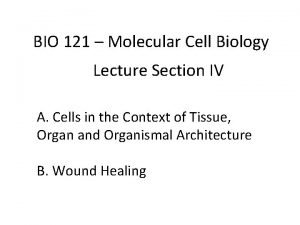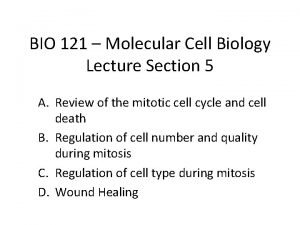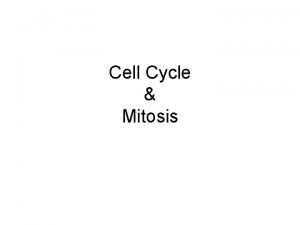Chapter 12 The Cell Cycle Active Lecture Questions











- Slides: 11

Chapter 12 The Cell Cycle Active Lecture Questions for use with Classroom Response Systems Biology, Seventh Edition Neil Campbell and Jane Reece Edited by William Wischusen, Louisiana State University Copyright © 2005 Pearson Education, Inc. publishing as Benjamin Cummings

Using the data in the table below, the best conclusion concerning the difference between the cell types is: Minutes Spent in Cell Cycle Phases Cell Type G 1 S G 2 12 16 Beta 18 24 Delta 100 0 18 48 Gamma 0 M 0 14 20 a) beta and gamma contain the same amount of DNA. b) beta contains more RNA than gamma. c) gamma contains 48 times more DNA and RNA than beta. d) beta has less DNA than gamma, but more than delta e) Delta cells can be found in quickly regenerating tissues Copyright © 2004 Pearson Education, Inc. publishing as Benjamin Cummings

Cytokinesis usually, but not always, follows mitosis. If a cell completed mitosis but not cytokinesis, what would be the result? a) a cell with a single large nucleus b) a cell with high concentrations of actin and myosin c) a cell with two abnormally small nuclei d) a cell with two nuclei e) a cell with two nuclei but with half the amount of DNA Copyright © 2004 Pearson Education, Inc. publishing as Benjamin Cummings

The decline of MPF activity at the end of mitosis is caused by: a. The destruction of the protein kinase (Cdk) b. Decreased synthesis of cyclin c. The degradation of cyclin d. Synthesis of DNA e. An increase in the cell’s volume-to-genome ratio Copyright © 2004 Pearson Education, Inc. publishing as Benjamin Cummings

Measurements of the amount of DNA per nucleus were taken on a large number of cells from a growing fungus. The measured DNA levels ranged from 3 to 6 picograms per nucleus. In which stage of the cell cycle was the nucleus with 6 picograms of DNA? a) G 0 b) G 1 c) S d) G 2 e) M Copyright © 2004 Pearson Education, Inc. publishing as Benjamin Cummings

A group of cells is assayed for DNA content immediately following mitosis and is found to have an average of 8 picograms of DNA per nucleus. Those cells would have _____ picograms at the end of the S phase and _____ picograms at the end of G 2. a) 8. . . 8 b) 8. . . 16 c) 16. . . 8 d) 16. . . 16 e) 12. . . 16 Copyright © 2004 Pearson Education, Inc. publishing as Benjamin Cummings

A particular cell has half as much DNA as some of the other cells in a mitotically active tissue. The cell in question is most likely in a) G 1. b) G 2. c) prophase. d) metaphase. e) anaphase. Copyright © 2004 Pearson Education, Inc. publishing as Benjamin Cummings

A cell in which of the following phases would have the least amount of DNA? a) G 0 b) G 2 c) prophase d) metaphase e) anaphase Copyright © 2004 Pearson Education, Inc. publishing as Benjamin Cummings

Which of the following statements about mitosis is not true? a. Mitosis occurs after DNA replication b. Mitosis is followed by cytokinesis, producing 2 genetically identical daughter cells c. Mitosis plays a role in growth, repair, and asexual reproduction d. In mitosis, only half of one’s genome is passed from the parent cell to daughter cells e. Mitosis is a continuous process with observable structural features. The general order of the processes are replication, alignment, and separation of chromosomes. Copyright © 2004 Pearson Education, Inc. publishing as Benjamin Cummings

Copyright © 2004 Pearson Education, Inc. publishing as Benjamin Cummings

10. The rhythmic changes in cyclin concentration in a cell cycle are due to a) its increased production once the restriction point is passed. b) the cascade of increased production once its enzyme is phosphorylated by MPF. c) its degradation, which is initiated by active MPF. d) the correlation of its production with the production of Cdk. e) the binding of the growth factor PDGF. Copyright © 2004 Pearson Education, Inc. publishing as Benjamin Cummings
 Section 10-2 cell division
Section 10-2 cell division Cell cycle and cell division
Cell cycle and cell division Biology.arizona.edu/cell bio/activities/cell cycle/01.html
Biology.arizona.edu/cell bio/activities/cell cycle/01.html Cell cycle mitosis
Cell cycle mitosis 01:640:244 lecture notes - lecture 15: plat, idah, farad
01:640:244 lecture notes - lecture 15: plat, idah, farad Chapter 4 cell theory and cell study
Chapter 4 cell theory and cell study Molecular cell biology lecture
Molecular cell biology lecture Molecular biology of the cell
Molecular biology of the cell And or boolean
And or boolean Primary active transport and secondary active transport
Primary active transport and secondary active transport Primary active transport vs secondary active transport
Primary active transport vs secondary active transport Chapter 5 principles of engine operation
Chapter 5 principles of engine operation





















